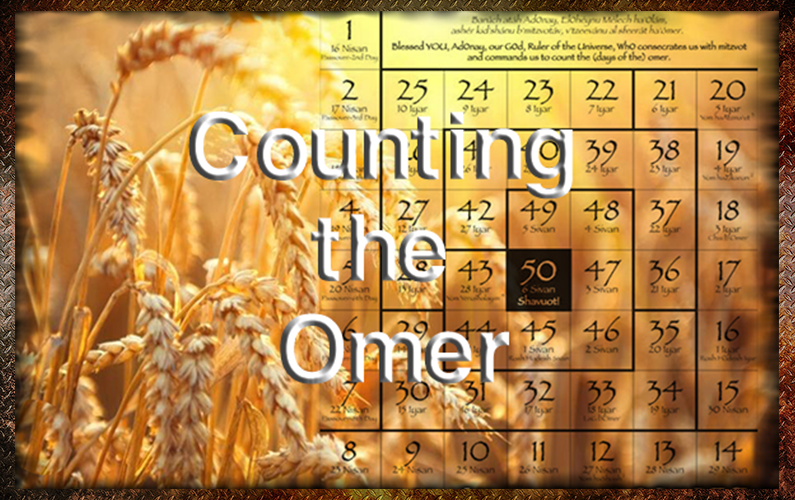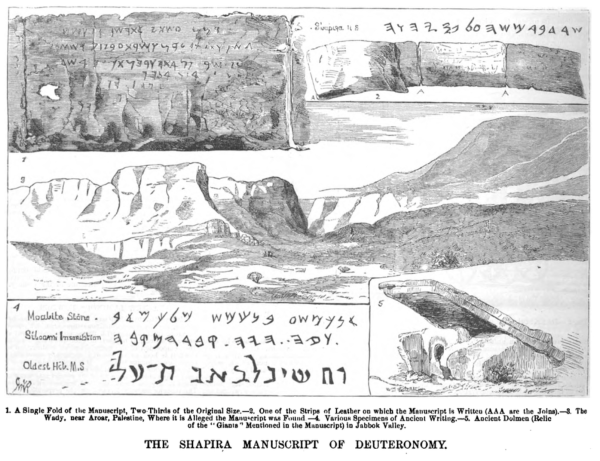Some of the more unique features of the manuscript that Shapira presented to the world in 1883 are contained in its version of the Ten Commandments. From the very beginning of the Shapira saga, these unique features created a sense of interest as well as objections.
As it turns out, the sense of interest was deserved and the objections unwarranted. Nearly everyone has heard of the famed Ten Commandments. According to the biblical record, these words were spoken from the midst of fire by God Himself at Horeb/Sinai to an assembly of people and then written on two stone tablets. These words represent the covenant.
We have two primary records of these words in the Bible (Exodus 20 and Deuteronomy 5). While they are popularly known as the Ten Commandments, they are never called by that designation in the Hebrew Bible. The three references (Exodus 34:28, Deuteronomy 4:13, and Deuteronomy 10:4) all record the name of these words of the covenant as ע ש ר ת ה ד ב ר י ם, literally, The Ten Words.
Anyone who carefully compares the two versions of the Ten Words contained within our Bible will notice differences between them. These differences are evident in English as well as Hebrew. 2 There are, for example, 172 Hebrew words in Exodus’s version of The Ten Words and 189 Hebrew words in Deuteronomy’s version. The two accounts are, of course, similar in many ways, but they also contain variants.
Both reports claim to present the words that God spoke (Exodus 20:1, Deuteronomy 5:19), and so the question is, what words did He say? Which version best represents the words spoken from the midst of the fire on the day of the assembly. Both accounts employ the third person when referring to God, suggesting that neither version is the original record of the Ten Words. And how are we to number the ten since the text provides little help in this regard?
In 1878, after nearly a month of careful study, Shapira produced a transcription of the sixteen leather strips. On 24 September 1883, he sent his transcription and a detailed commentary noting variations between the manuscript and the traditional texts of the Bible to Professor Konstantine Schlottmann at the University of Halle. There were notable variations in the order, arrangement, wording, and presentation of the Ten Words.
After consultation with Franz Delitzsch, Professor Schlottmann sent back a scolding reply to Shapira dated 7 October 1883. Shapira later wrote to Hermann Strack about this rebuke, reporting that among other criticisms, Schlottmann had said, “How I dare to call this forgery the Old Testament? Could I suppose for one minute that it is older than our unquestionable [sic] genuine ten commandments?”
3 Eduard Meyer, who examined and transcribed the manuscript in July of 1883 with Hermann Guthe wrote to his mentor Georg Ebers on 8 July 1883 informing him that when “Schlottmann … declared it forged, old Delitzsch made the indignant remark: ‘Don’t touch our Decalogue!’”
4 In an article titled, “A New Version of Deuteronomy,” which appeared in the 3 August 1883 edition of The Jewish Chronicle, it was reported, “It need scarcely be stated that if this turns out to be correct, these pieces of leather will possess a high value, not only in money, but also in a literary sense, for they contain some curious variations in the reading, among which we have an extra commandment, which is, ‘Thou shalt not hate thy brother in thy heart.’”
The claim that this manuscript contained an extra commandment has been repeated in modern times. Examples include Aviva and Shmuel Bar Am’s article of 2 November 2013, which appeared in The Times of Israel with the title, “In the Footsteps of a Master Forger.”
The report begins, “In 1883, respected antiques dealer Moses Wilhelm Shapira claimed to possess ancient scrolls of Deuteronomy. The text differed slightly from the accepted version: It has an 11 th commandment.”
Later in the article, we read, “In 1883, while dwelling here in luxury, Shapira was involved in a highly publicized scandal. He claimed to have in his possession scrolls of Deuteronomy dating back thousands of years, whose text differed slightly from the accepted version and added an 11 th Commandment to the Decalogue.
The 11th Commandment, according to the Shapira scroll, was ‘Thou shalt not hate thy brother in thy heart: I am GOD, thy GOD.’ The report caused a sensation, since the earliest biblical manuscripts at that time were only a few hundred years old.”
5 Even more recently, Ryan Morrison, in his 10 March 2021 article titled, “Shapira Scroll: Ancient Manuscript May Be Oldest Known Biblical Script,” said, “There is also an 11 th commandment that reads: ‘Thou shalt not hate they brother in thy heart: I am God, they God.’”
6 The confusion over whether the manuscript had ten or eleven “commandments” seems to originate with the wording of that 3 August 1883 article in The Jewish Press.
While the article mentioned “an extra commandment,” the writer never said that the manuscript contained eleven commandments, but instead said, “by joining the first and second commandments into one, this becomes the tenth in the Phenician [sic] version.”
There are only Ten Words in the manuscript. Each of The Ten Words in this Decalogue began on a new line and ended with the exact phrase in Hebrew, namely, א נ כ א ל ה ם א ל ה ך[I am Elohim your Elohim].
This feature clearly shows how the words were to be counted. I would kindly ask readers of this paper to help me set the record straight; – the manuscript that I call The Moses Scroll, 7 and that Idan Dershowitz calls The Valediction of Moses, 8 contained only ten words in its version of The Ten Words and not eleven.
1 This paper was originally published on my Author’s Blog – https://themosesscroll.com/did-shapiras-manuscript- contain-ten-or-eleven-commandments/.
2 See for example Ross K. Nichols, A Comparison of the Ten Words in English with Explanatory Notes, https://www.academia.edu/43772655/A_ Comparison_of_the_Ten_Words_in_English_ with_Explanatory_Notes.
3 Moses Shapira, letter to Hermann Strack, Jerusalem, 9 May 1883, “Papers Relative to M.W. Shapira’s Forged MS. of Deuteronomy (A.D. 1883–1884).” Add. MS. 41294 (London: British Library).
4 Letter from Eduard Meyer to Georg Ebers, 8 July 1883, “Der Briefwechsel zwischen Georg Ebers und Eduard Meyer (1874–1898),” Vorbemerkung von G. Audring. https://www.geschichte.hu-berlin.de/de/bereiche-und- lehrstuehle/alte-geschichte/forschung/briefe-meyer/ebers
5 https://www.timesofisrael.com/in-the-footsteps-of-a-master-forger/
6 https://www.msn.com/en-us/travel/news/shapira-scroll-ancient-manuscript-may-be-oldest-known-biblical- script/ar-BB1eswXJ
7 Ross K. Nichols, The Moses Scroll, (Saint Francisville: Horeb Press, 2021). For more information, visit https://themosesscroll.com. 8 Idan Dershowitz, The Valediction of Moses: A Proto-Biblical Book, (Tübingen: Mohr Siebeck, 2021).
https://www.academia.edu/67707696/Did_Shapiras_Manuscript_Contain_Ten_or_Eleven_Commandments









